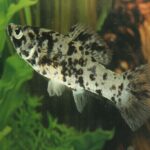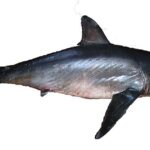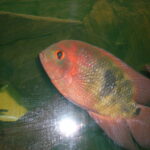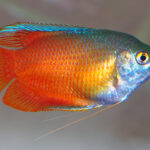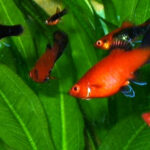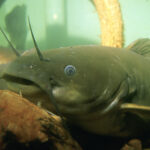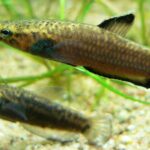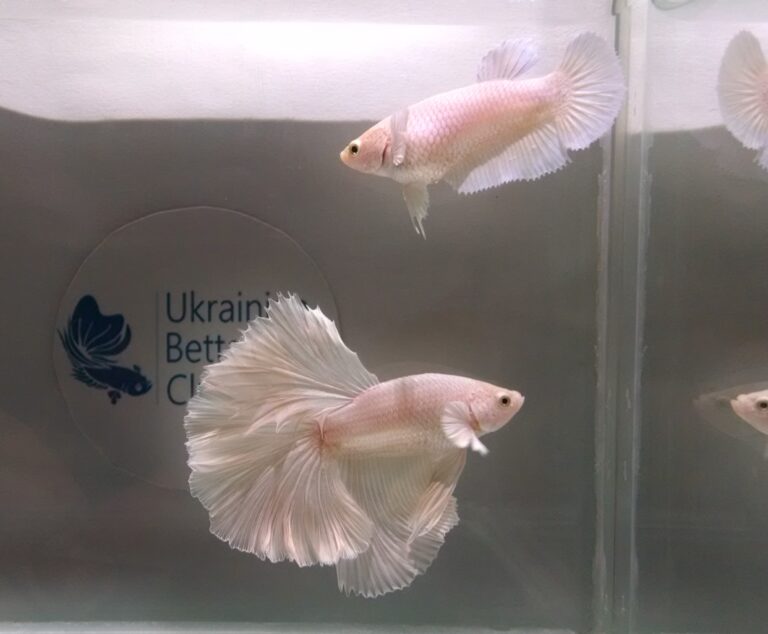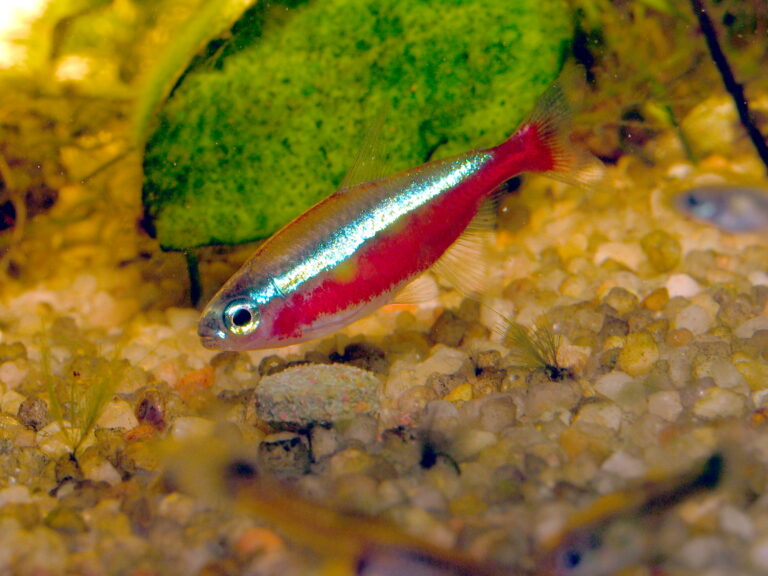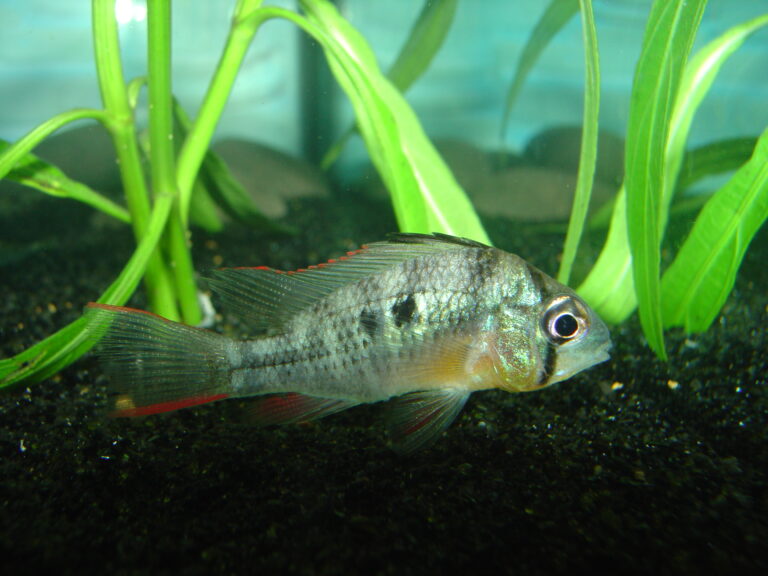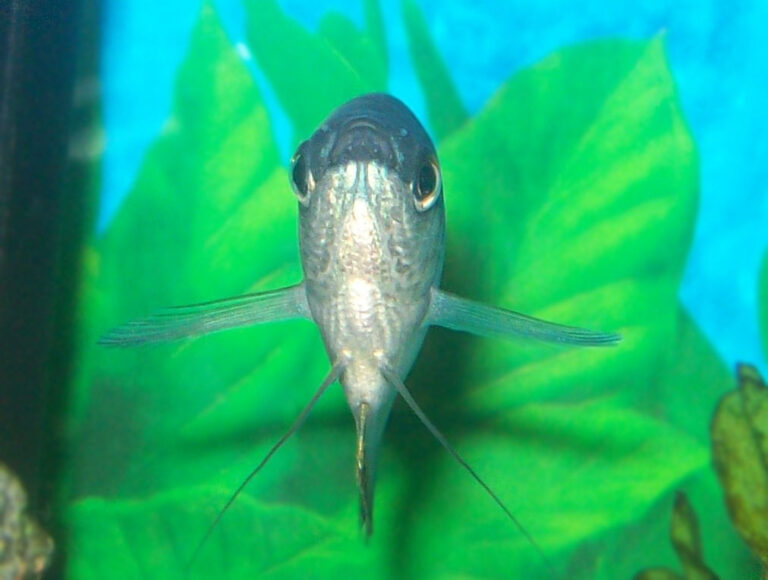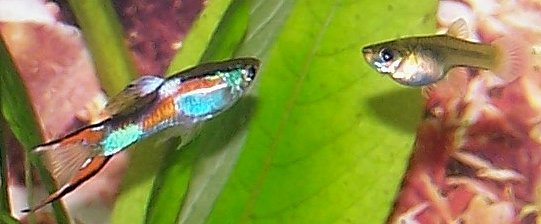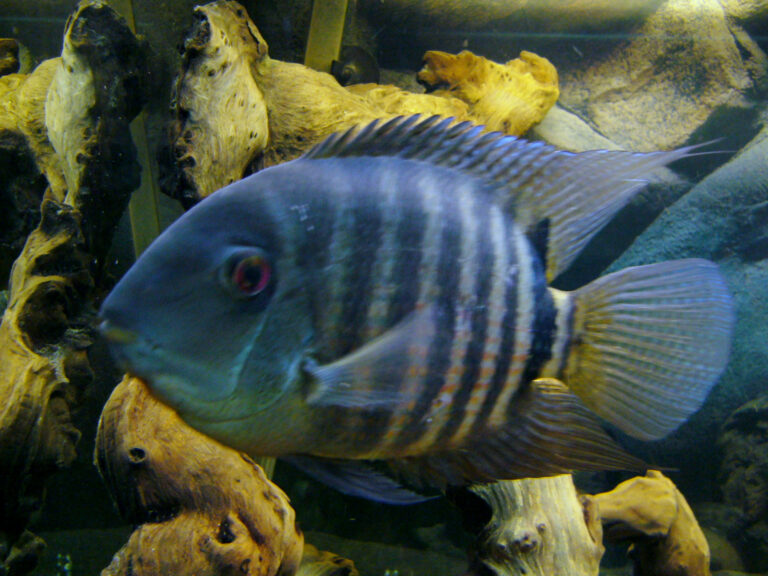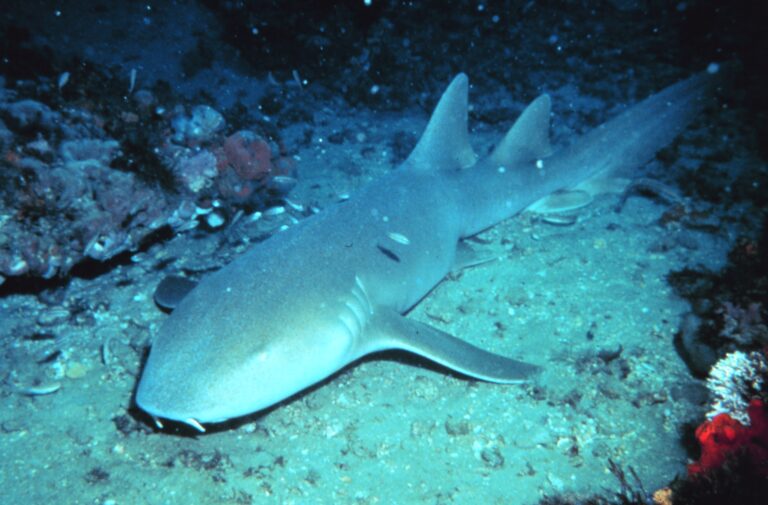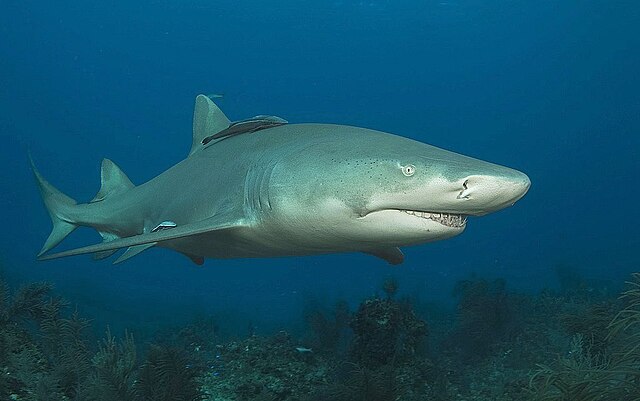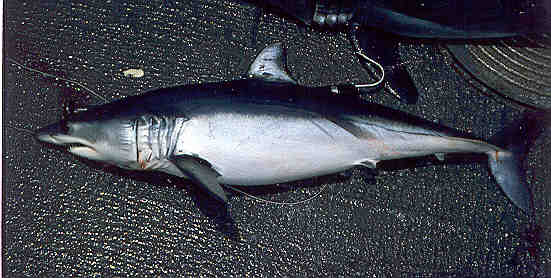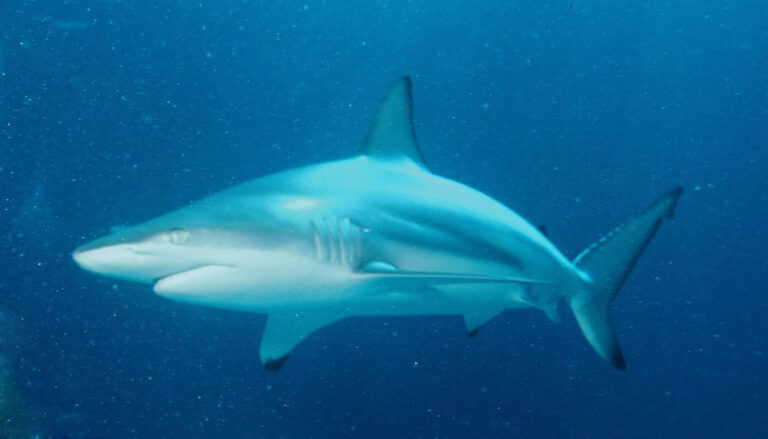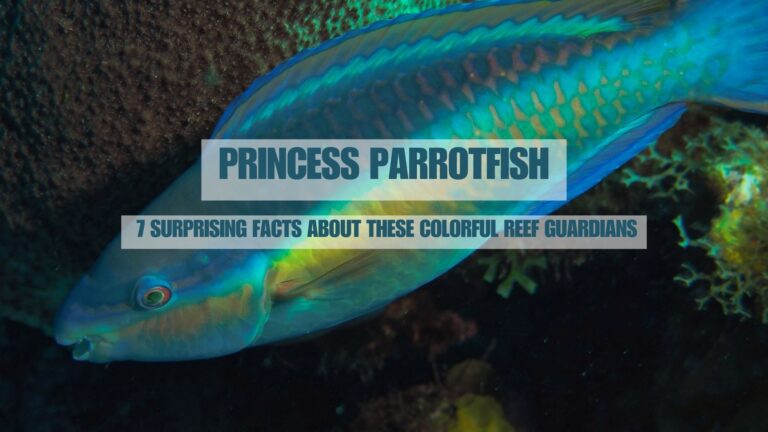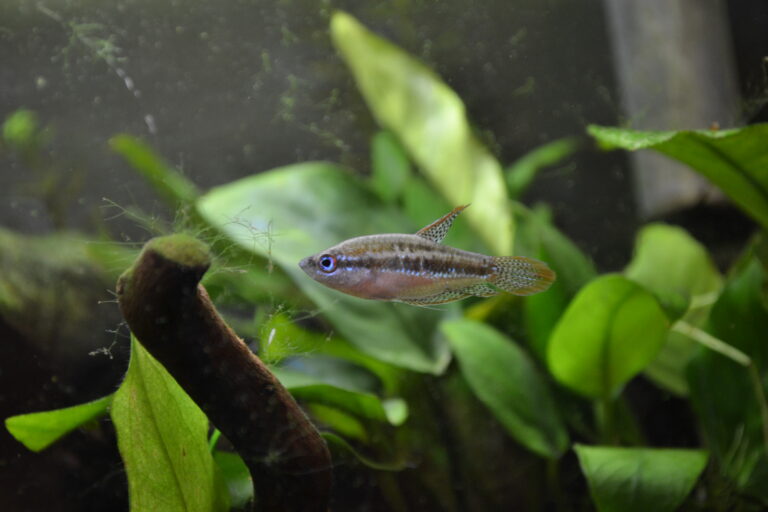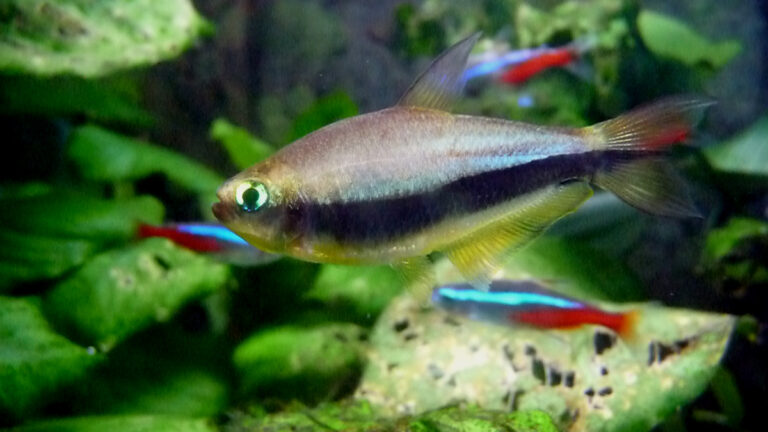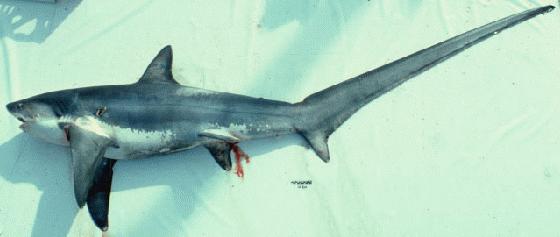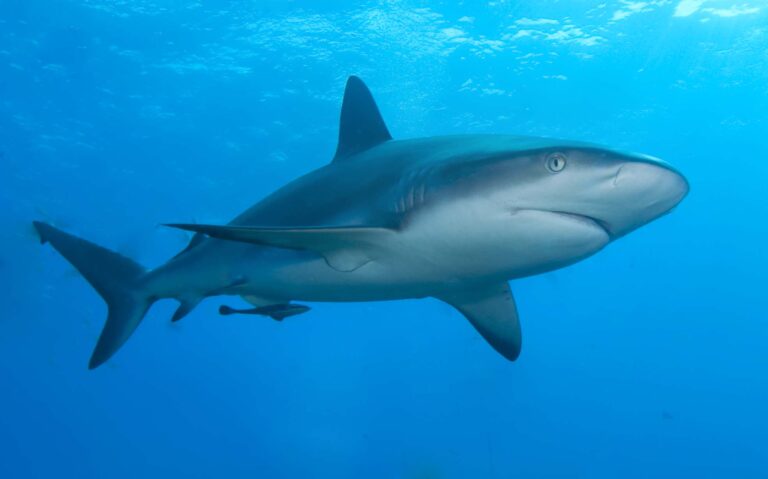Silver Dollar Fish
By Ryan Maron | Last Modified: June 8, 2025
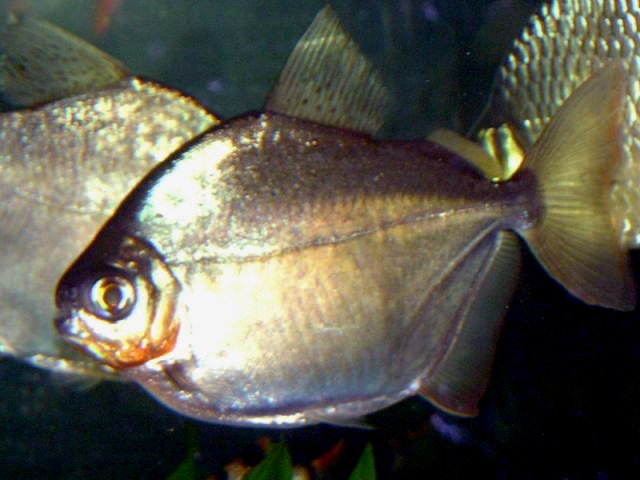
The Silver Dollar Fish (*Metynnis argenteus*) stands as one of South America’s most recognizable freshwater species, renowned for its distinctive disc-shaped body and shimmering silver coloration. This peaceful characin has captured the attention of both aquarists and ichthyologists due to its unique feeding ecology and complex social behaviors within natural river systems. Native to the Amazon and Orinoco river basins, the Silver Dollar Fish plays a crucial ecological role as a primary consumer, helping to control aquatic vegetation while serving as an important food source for larger predatory species.
The species represents a fascinating example of herbivorous adaptation among the Characidae family, possessing specialized dental structures that enable efficient processing of plant matter. Their schooling behavior and seasonal migration patterns make them integral components of South American freshwater ecosystems, influencing both plant community dynamics and nutrient cycling processes. Understanding *Metynnis argenteus* provides valuable insights into the complex relationships that sustain tropical river biodiversity.
| Feature | Details |
|---|---|
| Common Name | Silver Dollar Fish |
| Scientific Name | Metynnis argenteus |
| Family | Characidae |
| Typical Size | 12-15 cm (4.7-5.9 inches), 80-120 grams |
| Habitat | Slow-moving rivers and flooded forests |
| Diet | Herbivorous – aquatic plants and fruits |
| Distribution | Amazon and Orinoco basins |
| Conservation Status | Least Concern |
Taxonomy & Classification
The Silver Dollar Fish belongs to the order Characiformes, specifically within the diverse family Characidae, which encompasses over 1,200 described species across South and Central America. First scientifically described by Cope in 1878, *Metynnis argenteus* represents the type species of the genus Metynnis, commonly known as silver dollars or disk tetras. The genus name derives from the Greek words “meta” (beyond) and “ynnis” (plowshare), referencing the distinctive compressed body shape that characterizes these fish.
Within the Characidae family, the subfamily Serrasalminae includes both herbivorous silver dollars and their carnivorous relatives, the piranhas. This evolutionary relationship demonstrates the remarkable dietary diversification that has occurred within this taxonomic group. *Metynnis argenteus* shares the subfamily with approximately 90 other species, including various Metynnis species, Mylossoma, and Colossoma genera.
The species exhibits significant morphological variation across its range, leading to ongoing taxonomic discussions among ichthyologists. Several subspecies have been proposed based on geographic distribution and minor morphological differences, though molecular studies continue to refine our understanding of species boundaries within the genus. The closely related *Metynnis hypsauchen* and *Metynnis lippincottianus* often require careful examination to distinguish from *M. argenteus* in scientific collections.
Phylogenetic analyses utilizing both morphological and molecular data have established the genus Metynnis as monophyletic, with *M. argenteus* occupying a basal position within the genus. This positioning suggests that the species represents an early divergent lineage that has maintained relatively primitive characteristics compared to other Metynnis species.
Physical Description
The Silver Dollar Fish exhibits a highly compressed, disc-shaped body profile that gives the species its common name. Adult specimens typically reach 12-15 centimeters in standard length, with exceptional individuals occasionally exceeding 16 centimeters. The body depth equals approximately 75-80% of the standard length, creating the characteristic circular silhouette when viewed laterally. Sexual dimorphism becomes apparent in mature specimens, with males developing a more pronounced anal fin and slightly deeper body proportions.
The species displays a predominantly silver coloration with subtle variations across the body regions. The dorsal surface exhibits a darker olive-green to bronze hue that gradually transitions to brilliant silver along the lateral surfaces. The ventral region maintains a pearl-white to pale silver coloration. Small, dark scales create a subtle reticulated pattern across the body, becoming more pronounced under certain lighting conditions.
The head comprises approximately 25% of the standard length, with large, prominent eyes positioned laterally. The mouth is small and terminal, equipped with specialized teeth adapted for herbivorous feeding. The dental formula includes tricuspid teeth in both jaws, with the central cusp being the most prominent. This tooth arrangement facilitates efficient cutting and processing of plant material.
Fin morphology reflects the species’ ecological adaptations. The dorsal fin contains 16-18 soft rays and extends along much of the dorsal surface, providing enhanced maneuverability in dense vegetation. The anal fin exhibits sexual dimorphism, with males developing an elongated, more pointed profile during breeding season. The caudal fin displays a deeply forked structure with equal lobes, optimized for efficient swimming in open water environments.
The lateral line system consists of 58-65 scales, extending from the operculum to the caudal peduncle. This sensory system enables detection of water movements and pressure changes, crucial for schooling behavior and predator avoidance. The species possesses a complete lateral line that remains functional throughout the fish’s life cycle.
Habitat & Distribution
*Metynnis argenteus* inhabits the vast river systems of South America, with its primary distribution encompassing the Amazon River basin and the Orinoco River system. The species demonstrates remarkable adaptability to various freshwater environments, from main river channels to seasonal floodplains and tributary systems. Their natural range extends from the Guianas through Brazil, Peru, Colombia, and Venezuela, covering an estimated area of over 6 million square kilometers.
The Silver Dollar Fish prefers slow-moving to moderately flowing waters with temperatures ranging from 24-28°C (75-82°F). These fish show strong preferences for areas with abundant aquatic vegetation, including both submerged and floating plant communities. During the wet season, they migrate into flooded forest areas where they exploit the increased availability of terrestrial fruits and vegetation that falls into the water.
Water chemistry parameters in their natural habitat typically include pH levels between 6.0-7.5, with soft to moderately hard water conditions. Dissolved oxygen levels remain consistently high due to the flowing nature of their preferred habitats. The species exhibits tolerance for slight variations in water parameters, which contributes to their successful colonization of diverse aquatic environments.
Seasonal migrations represent a critical aspect of Silver Dollar Fish ecology. During the dry season, populations concentrate in deeper river channels and permanent water bodies. As water levels rise during the wet season, schools disperse into newly flooded areas, including gallery forests and grassland areas. This migration pattern synchronizes with reproductive cycles and food availability, particularly the fruiting periods of riparian vegetation.
The species demonstrates depth preferences typically ranging from surface waters to approximately 10 meters deep, though they occasionally venture into deeper areas during certain seasonal conditions. Microhabitat selection often involves areas with overhanging vegetation, fallen trees, and complex structural features that provide both feeding opportunities and protection from predators.
Sympatric species within their range include numerous other characins, catfish, and cichlids, creating complex ecological communities. The Silver Dollar Fish’s habitat requirements overlap significantly with various tetra species, though their larger size and specialized feeding niche reduce direct competition for resources.
Diet & Feeding Behavior
The Silver Dollar Fish demonstrates specialized herbivorous feeding behavior that distinguishes it from many other characin species. Their diet consists primarily of aquatic plants, fallen fruits, seeds, and occasionally small invertebrates. The species has evolved sophisticated feeding strategies that enable efficient exploitation of plant resources throughout their range.
Aquatic vegetation forms the cornerstone of their diet, with preferences for soft-leaved plants such as Vallisneria, Cabomba, and various species of aquatic grasses. Their tricuspid teeth enable precise cutting of plant material, while their pharyngeal teeth process the vegetation for optimal digestion. Gut content analyses reveal that plant matter comprises 85-90% of their dietary intake during most seasons.
During the flood season, Silver Dollar Fish exhibit remarkable behavioral adaptations to exploit terrestrial food sources. They actively feed on fruits and seeds from riparian trees, including species of Ficus, Cecropia, and palm fruits. This frugivorous behavior provides essential nutrients and energy reserves that support reproductive activities and seasonal migrations.
Feeding behavior exhibits distinct temporal patterns, with peak activity occurring during dawn and dusk periods. Schools coordinate their feeding activities, often creating feeding frenzies when encountering abundant food sources. This collective feeding behavior maximizes individual foraging efficiency while maintaining the protective benefits of schooling.
The species employs various feeding techniques depending on the food source. Surface feeding occurs when consuming floating fruits and seeds, while benthic feeding targets submerged vegetation and fallen organic matter. Their ability to hover and maintain precise positioning enables selective feeding on preferred plant parts while avoiding less digestible components.
Seasonal dietary shifts reflect resource availability and reproductive requirements. During the dry season, the diet becomes more restricted to available aquatic vegetation, while the wet season offers diverse opportunities for fruit and seed consumption. These dietary variations influence growth rates, body condition, and reproductive success.
Digestive adaptations include an elongated intestinal tract that facilitates efficient processing of plant cellulose. Symbiotic gut bacteria assist in breaking down complex plant compounds, enabling the species to extract maximum nutritional value from their herbivorous diet. This digestive efficiency represents a key evolutionary adaptation that has enabled their ecological success.
Behavior & Adaptations
The Silver Dollar Fish exhibits complex social behaviors centered around schooling, which serves multiple ecological functions including predator avoidance, feeding efficiency, and information transfer. Schools typically consist of 50-200 individuals, though aggregations of over 1,000 fish have been observed during migration periods. These formations demonstrate sophisticated coordination mechanisms that enable rapid response to environmental changes and threats.
Schooling behavior varies with age and environmental conditions. Juvenile fish form tighter, more cohesive schools with individuals maintaining precise spacing and synchronized movements. Adult schools exhibit more flexible formations, allowing for individual foraging while maintaining group cohesion. The species employs both polarized and non-polarized schooling patterns depending on the behavioral context.
Communication within schools occurs through multiple sensory modalities. Visual cues include body positioning, fin movements, and subtle color changes that convey information about direction, feeding opportunities, and potential threats. The lateral line system detects hydrodynamic disturbances created by neighboring fish, enabling precise coordination of group movements.
Territorial behavior becomes apparent during breeding season, when males establish and defend spawning territories. These temporary territories are typically located near suitable spawning substrates and are defended through aggressive displays and chasing behaviors. Outside of breeding season, the species shows minimal territorial tendencies, focusing on cooperative behaviors that benefit the entire school.
Diel activity patterns reflect evolutionary adaptations to predator pressure and resource availability. Peak activity occurs during crepuscular periods when light conditions provide optimal foraging opportunities while reducing visibility to visual predators. Nocturnal behavior includes resting periods where schools maintain loose formations near protective structures.
Seasonal behavioral adaptations include extensive migrations that synchronize with hydrological cycles. These movements require sophisticated navigation abilities and group coordination across vast distances. The species demonstrates remarkable site fidelity, returning to specific areas annually for breeding and feeding activities.
Predator avoidance strategies include rapid escape responses, confusion effects created by tight schooling, and habitat selection that maximizes protective cover. When threatened, schools can execute coordinated escape maneuvers that include rapid direction changes and temporary dispersal followed by quick reaggregation.
Learning behaviors have been documented in captive populations, including recognition of feeding schedules, habitat preferences, and social hierarchies. These cognitive abilities likely contribute to their success in complex natural environments where rapid adaptation to changing conditions provides survival advantages.
Reproduction & Life Cycle
The reproductive biology of Silver Dollar Fish demonstrates remarkable synchronization with environmental conditions and seasonal cycles. Breeding typically occurs during the rising water period at the beginning of the flood season, when water temperatures increase and food availability reaches peak levels. This timing ensures optimal conditions for spawning, egg development, and larval survival.
Sexual maturity occurs at approximately 12-18 months of age, corresponding to a standard length of 8-10 centimeters. Males develop distinct breeding characteristics including intensified coloration, elongated anal fin rays, and increased territorial behaviors. Females exhibit swollen abdomens during spawning readiness, with mature ovaries visible through the translucent body wall.
Courtship behavior involves elaborate displays where males establish territories near suitable spawning substrates. These areas typically include sandy or muddy bottoms adjacent to aquatic vegetation. Males perform circular swimming patterns while displaying intensified colors and extended fins to attract females. Multiple males may compete for prime spawning locations, engaging in ritualized aggressive encounters.
Spawning occurs during early morning hours when water temperatures are optimal. Females deposit between 1,000-2,000 adhesive eggs over prepared spawning substrates, with males immediately fertilizing the eggs through synchronized release of sperm. The eggs are approximately 1.2-1.5 millimeters in diameter and exhibit strong adhesive properties that secure them to the substrate.
Parental care is minimal, with adults abandoning the spawning site shortly after egg deposition. The eggs rely on environmental conditions for successful development, with water temperature and oxygen levels playing critical roles in determining survival rates. Incubation period ranges from 4-6 days depending on water temperature, with optimal development occurring at 26-28°C.
Larval development progresses through several distinct stages. Newly hatched larvae possess large yolk sacs that provide nutrition for the first 5-7 days. Free-swimming larvae begin actively feeding on zooplankton, particularly rotifers and small copepods. Growth rates during this period are rapid, with larvae doubling in size within the first two weeks.
Juvenile development includes gradual transition from planktonic to herbivorous feeding as digestive systems mature. Young fish begin incorporating small plant particles into their diet at approximately 3-4 weeks of age. Sexual differentiation becomes apparent at 6-8 months, though full reproductive maturity requires additional development time.
Life span in natural conditions is estimated at 8-12 years, with growth rates slowing significantly after reaching sexual maturity. Reproductive output increases with age and size, with larger females producing substantially more eggs than younger individuals. Environmental conditions strongly influence reproductive success, with flood timing and intensity affecting both spawning triggers and offspring survival rates.
Predators & Threats
The Silver Dollar Fish faces predation pressure from diverse aquatic predators throughout its life cycle, with vulnerability varying significantly based on size, habitat use, and seasonal factors. Juvenile fish experience the highest predation rates due to their small size and limited escape capabilities, while adults benefit from enhanced swimming abilities and sophisticated anti-predator behaviors.
Primary predators include large characins such as payara (*Hydrolycus* species), which possess specialized dentition adapted for capturing silvery prey. These piscivorous fish actively hunt Silver Dollar Fish schools, using their impressive speed and agility to isolate individuals from the protective group. Predation rates by characins peak during the dry season when prey concentrations increase in reduced water bodies.
Catfish represent another significant predator group, particularly during nocturnal periods when Silver Dollar Fish exhibit reduced vigilance. Large pimelodid catfish such as *Pseudoplatystoma* species employ ambush tactics, using their excellent chemoreception to locate schools in turbid waters. These predators pose the greatest threat to adult Silver Dollar Fish due to their size and gape limitations of smaller predators.
Cichlid predators, including various *Cichla* species, utilize visual hunting strategies that are particularly effective in clear water conditions. These predators demonstrate learning behaviors that enable them to anticipate schooling patterns and exploit temporary vulnerabilities. Juvenile Silver Dollar Fish are especially susceptible to medium-sized cichlids that inhabit similar shallow water environments.
Avian predators play important roles in Silver Dollar Fish mortality, particularly during surface feeding activities. Cormorants, herons, and kingfishers have been observed successfully capturing individuals that venture near the water surface. These predation events often trigger dramatic escape responses in entire schools, demonstrating the impact of aerial threats on behavior patterns.
Reptilian predators include various snake species and caimans, though their impact on Silver Dollar Fish populations remains less documented. Large snakes such as *Eunectes* species may occasionally consume adult fish, while smaller aquatic snakes pose threats primarily to juvenile individuals.
Anthropogenic threats have emerged as increasingly significant factors affecting Silver Dollar Fish populations. Habitat modification through dam construction alters natural flow regimes and disrupts migration patterns essential for successful reproduction. Deforestation reduces the availability of terrestrial food sources that are crucial during flood seasons, potentially impacting nutritional status and reproductive success.
Water pollution from agricultural runoff, mining activities, and urban development creates additional stressors that may increase susceptibility to disease and reduce reproductive success. Changes in water chemistry can also affect the growth and survival of aquatic vegetation that forms the foundation of Silver Dollar Fish feeding ecology.
Overfishing for the aquarium trade has created localized population pressures in areas with easy access to collection sites. While the species remains abundant throughout much of its range, intensive collection in specific regions may require monitoring to ensure sustainable harvest levels. The demand for Silver Dollar Fish in international aquarium markets continues to drive collection activities across their native range.
Conservation Status
The Silver Dollar Fish currently maintains a conservation status of Least Concern according to the International Union for Conservation of Nature (IUCN), reflecting its wide distribution, large population size, and apparent stability across most of its range. However, this designation requires ongoing evaluation as environmental pressures continue to intensify throughout South American freshwater systems.
Population assessments indicate that *Metynnis argenteus* remains abundant in most major river systems within its native range. The species’ adaptability to various aquatic environments and its herbivorous feeding strategy provide advantages in the face of ecosystem changes that might negatively impact more specialized species. Their ability to exploit both aquatic and terrestrial food sources during seasonal floods contributes to population resilience.
Regional variations in population status reflect the heterogeneous nature of conservation challenges across South America. Areas with minimal human impact continue to support robust Silver Dollar Fish populations, while regions experiencing intensive development show signs of population decline. The Amazon basin’s vast scale and limited accessibility provide refuge areas that maintain important breeding populations.
Habitat conservation efforts focus on protecting critical spawning and feeding areas, particularly flooded forest ecosystems that provide essential resources during reproductive periods. The preservation of riparian vegetation proves crucial for maintaining the terrestrial food sources that support Silver Dollar Fish nutrition and reproductive success. Conservation initiatives targeting these habitats benefit multiple species while addressing the specific needs of herbivorous fish communities.
Water quality monitoring programs have been established in several countries to track changes in chemical parameters that could affect Silver Dollar Fish populations. These efforts help identify emerging threats and guide management decisions for watershed protection. Collaboration between government agencies, research institutions, and conservation organizations enhances the effectiveness of monitoring programs.
The species’ importance in the aquarium trade has led to initiatives promoting sustainable collection practices and captive breeding programs. These efforts aim to reduce pressure on wild populations while maintaining the availability of Silver Dollar Fish for aquarium enthusiasts. Captive breeding programs also provide opportunities for research and genetic preservation efforts.
Climate change poses emerging challenges for Silver Dollar Fish conservation, particularly through alterations in precipitation patterns and temperature regimes. Changes in flood timing and intensity could disrupt reproductive cycles and food availability, requiring adaptive management strategies. Research into climate impacts on freshwater ecosystems provides crucial information for long-term conservation planning.
International cooperation plays a vital role in Silver Dollar Fish conservation, given the species’ distribution across multiple countries. Trans-boundary conservation initiatives help coordinate protection efforts and ensure that migration corridors remain intact. These collaborative approaches prove essential for maintaining ecosystem connectivity and genetic diversity across the species’ range.
Human Interaction
The relationship between humans and Silver Dollar Fish encompasses multiple dimensions, from traditional subsistence fishing to modern aquarium trade and scientific research. Indigenous communities throughout the Amazon and Orinoco basins have utilized these fish as food sources for centuries, developing sophisticated knowledge of their behavior, seasonal patterns, and ecological roles within river systems.
Subsistence fishing practices often target Silver Dollar Fish during their seasonal migrations when large schools aggregate in predictable locations. Traditional fishing methods include the use of nets, traps, and spears, with timing carefully coordinated to maximize catch efficiency. These practices generally operate within sustainable limits due to the small scale of local communities and their dependence on maintaining healthy fish populations.
The international aquarium trade represents the most significant commercial interaction with Silver Dollar Fish populations. Their attractive appearance, peaceful temperament, and relative hardiness make them popular choices for large community aquariums. Annual export numbers from South American countries reach several hundred thousand individuals, generating important economic benefits for local communities involved in collection and export operations.
Aquarium keeping requirements for Silver Dollar Fish reflect their natural ecology and social behaviors. Successful maintenance requires large tanks with adequate space for schooling, appropriate water parameters, and suitable vegetation. Many aquarists appreciate the species for their peaceful nature and compatibility with other large community fish, though their herbivorous appetite requires careful plant selection in planted aquariums.
Commercial aquaculture operations have been established in several countries to meet aquarium trade demand while reducing pressure on wild populations. These facilities employ specialized breeding techniques that account for the species’ reproductive requirements and social behaviors. Captive breeding programs have achieved considerable success, though wild-caught specimens continue to dominate market supply.
Scientific research involving Silver Dollar Fish has contributed significantly to our understanding of herbivorous fish ecology, schooling behavior, and tropical freshwater ecosystem dynamics. Research institutions utilize the species as model organisms for studies on feeding ecology, social behavior, and physiological adaptations. This research provides valuable insights applicable to broader conservation and management efforts.
Educational programs featuring Silver Dollar Fish help raise awareness about South American freshwater biodiversity and conservation challenges. Public aquariums and educational institutions use these fish to demonstrate ecological concepts such as herbivory, schooling behavior, and seasonal migrations. Their engaging appearance and interesting behaviors make them effective ambassadors for freshwater conservation.
Ecotourism initiatives in some regions capitalize on Silver Dollar Fish aggregations to attract visitors interested in observing natural fish behavior. Sport fishing operations occasionally target these fish, though their primarily herbivorous diet makes them challenging to catch using traditional angling methods. These activities generate economic incentives for habitat protection while providing opportunities for environmental education.
The species has also found applications in aquaponics systems where their herbivorous nature and waste production characteristics contribute to sustainable food production methods. Research into their potential for integrated farming systems continues to expand, offering alternatives to traditional aquaculture approaches that may benefit both food security and environmental sustainability goals.
Interesting Facts
Silver Dollar Fish possess several remarkable adaptations that distinguish them from other freshwater species. Their ability to process cellulose-rich plant material surpasses that of most other characins, thanks to specialized gut bacteria that break down complex plant compounds. This digestive efficiency enables them to extract substantial nutrition from food sources that would be indigestible to carnivorous relatives.
The species demonstrates remarkable longevity in aquarium settings, with documented lifespans exceeding 15 years under optimal conditions. This longevity far exceeds their estimated natural lifespan, suggesting that predation pressure and environmental stressors significantly impact wild populations. The contrast between captive and wild lifespans provides insights into natural mortality factors affecting freshwater fish communities.
Behavioral studies have revealed that Silver Dollar Fish can recognize individual tank mates and develop complex social hierarchies within established groups. These cognitive abilities include memory formation, learning from experience, and problem-solving skills that enable adaptation to changing environmental conditions. Such intelligence levels were previously underestimated in herbivorous fish species.
The species exhibits unique feeding behaviors when encountering new plant species, including tentative sampling and gradual acceptance processes. This behavioral flexibility has enabled successful colonization of diverse habitats and adaptation to seasonal changes in food availability. Their feeding preferences can also be modified through social learning from other group members.
Silver Dollar Fish demonstrate remarkable swimming efficiency, with streamlined body shapes and coordinated fin movements that minimize energy expenditure during long-distance migrations. Their ability to maintain formation swimming for extended periods enables them to exploit scattered food resources across vast river systems while maintaining the protective benefits of schooling.
The species’ role in seed dispersal for aquatic and riparian plants remains largely unexplored but potentially significant. Their consumption of fruits and seeds during flood seasons, combined with their extensive movements, suggests they may function as important vectors for plant genetic exchange across river systems. This ecological service could prove crucial for maintaining plant diversity in fragmented habitats.
Unique adaptations for processing plant material include specialized pharyngeal teeth that continue growing throughout their lives to compensate for wear from constant plant processing. This tooth replacement system enables sustained herbivorous feeding across their extended lifespans, contrasting with the fixed dentition of many other fish species.
The species has been observed engaging in cooperative feeding behaviors where individuals work together to process large pieces of plant material. These behaviors suggest sophisticated social coordination abilities that extend beyond simple schooling responses. Such cooperation may provide significant advantages when exploiting challenging food sources that require coordinated effort to access.
Color variations in Silver Dollar Fish populations reflect both genetic diversity and environmental influences. Some populations exhibit subtle differences in hue and pattern intensity that may relate to local habitat conditions or dietary differences. These variations contribute to the species’ aesthetic appeal in aquarium settings and provide insights into evolutionary adaptation processes.
Recent research has revealed that Silver Dollar Fish possess excellent hearing abilities that enable detection of subtle environmental sounds. This acoustic sensitivity contributes to their predator avoidance capabilities and may facilitate long-distance communication within schools. The discovery of these abilities has prompted renewed interest in the sensory ecology of freshwater fish communities.
Frequently Asked Questions
How large do Silver Dollar Fish grow in home aquariums?
Silver Dollar Fish typically reach 12-15 centimeters (4.7-5.9 inches) in home aquariums, similar to their size in natural habitats. Growth rates depend on tank size, water quality, diet, and social conditions. Providing adequate space and proper nutrition enables them to reach their full size potential, while overcrowding or poor conditions may result in stunted growth. Most specimens achieve adult size within 18-24 months under optimal aquarium conditions.
Can Silver Dollar Fish be kept with other aquarium species?
Silver Dollar Fish are generally peaceful and compatible with many other large community fish species. They coexist well with other peaceful characins, medium to large catfish, and non-aggressive cichlids. However, their herbivorous appetite makes them unsuitable for planted aquariums unless robust, fast-growing plants are selected. Small fish may be inadvertently intimidated by their active schooling behavior, so tank mates should be of similar or larger size.
What plants are safe to keep with Silver Dollar Fish?
Very few aquarium plants remain safe from Silver Dollar Fish, as they will consume most soft-leaved vegetation. Hardy species such as Anubias, Java Fern, and some Cryptocoryne varieties may survive due to their tough leaves and bitter compounds. Artificial plants provide a practical alternative for aquarists who want plant-like aesthetics without the risk of consumption. Providing regular vegetable supplements helps reduce their interest in aquarium plants.
How many Silver Dollar Fish should be kept together?
Silver Dollar Fish should be kept in groups of at least 5-6 individuals to satisfy their natural schooling instincts. Larger groups of 8-10 or more fish display more natural behaviors and reduced stress levels. Single or paired fish often become withdrawn and may exhibit abnormal behaviors. The tank size should accommodate the increased bioload and swimming space requirements of larger groups, with minimum recommendations of 380 liters (100 gallons) for a small school.
Conclusion
The Silver Dollar Fish represents a remarkable example of evolutionary adaptation to herbivorous feeding within the diverse Characidae family. Their specialized ecological role as primary consumers in South American freshwater ecosystems demonstrates the complex relationships that maintain biodiversity in these critical habitats. Understanding their behavior, reproduction, and ecological requirements provides valuable insights for both conservation efforts and sustainable aquarium practices. As environmental pressures continue to intensify throughout their native range, ongoing research and conservation initiatives remain essential for ensuring the long-term survival of these distinctive freshwater fish and the ecosystems they inhabit.
Share The Article:
More Fish Species:
-
Rosetail Betta
The Rosetail Betta (Betta splendens) stands as one of the most visually striking variations within the diverse world of…
-
Cardinal Tetra
The Cardinal Tetra (Paracheirodon axelrodi) stands as one of the most vibrant and sought-after freshwater aquarium fish in the…
-
Bolivian Ram
The Bolivian Ram (Mikrogeophagus altispinosus) stands as one of South America’s most captivating cichlid species, representing a prime example…
-
Blue Gourami
The Blue Gourami (*Trichogaster trichopterus*) stands as one of the most recognizable and adaptable freshwater fish species in tropical…
-
Endlers Livebearer
The Endlers Livebearer (Poecilia wingei) stands as one of the most captivating freshwater fish species in the aquarium trade…
-
Severum Cichlid
The Severum Cichlid represents one of South America’s most recognizable and ecologically significant freshwater fish species. Known scientifically as…
Discover
-
Nurse Shark
The Nurse Shark (Ginglymostoma cirratum) stands as one of the most recognizable and ecologically significant bottom-dwelling sharks in tropical…
-
Great White Shark
The Great White Shark (*Carcharodon carcharias*) stands as one of the ocean’s most formidable apex predators, commanding respect and…
-
Lemon Shark
The Lemon Shark (*Negaprion brevirostris*) represents one of the most scientifically studied and ecologically significant predators in coastal marine…
-
Shortfin Mako Shark
The Shortfin Mako Shark stands as one of the ocean’s most remarkable predators, combining exceptional speed with sophisticated hunting…
-
Texas Fishing License Guide: 2025 Costs & Requirements
I still remember the day a Texas game warden approached me on Lake Texoma while I was reeling in…
-
Blacktip Shark
The Blacktip Shark (Carcharhinus limbatus) stands as one of the most recognizable and ecologically significant predators in tropical and…
Discover
-
Princess Parrotfish: 7 Surprising Facts About These Colorful Reef Guardians
When it comes to the underwater world, few fish capture my imagination quite like the princess parrotfish. The first…
-
Sparkling Gourami
The Sparkling Gourami represents one of the most captivating miniature freshwater species available to aquarium enthusiasts and serves as…
-
Pensacola Fishing Tides Decoded: Fish More, Catch More
Look, I’ve spent the better part of my fishing life getting absolutely schooled by Pensacola’s tides. Just last month,…
-
Emperor Tetra
The Emperor Tetra (*Nematobrycon palmeri*) stands as one of the most distinctive and sought-after freshwater fish species in the…
-
Thresher Shark
The Thresher Shark represents one of the ocean’s most distinctive and captivating apex predators, renowned for its extraordinarily elongated…
-
Caribbean Reef Shark
The Caribbean Reef Shark (*Carcharhinus perezi*) stands as one of the most recognizable and ecologically significant predators patrolling the…

